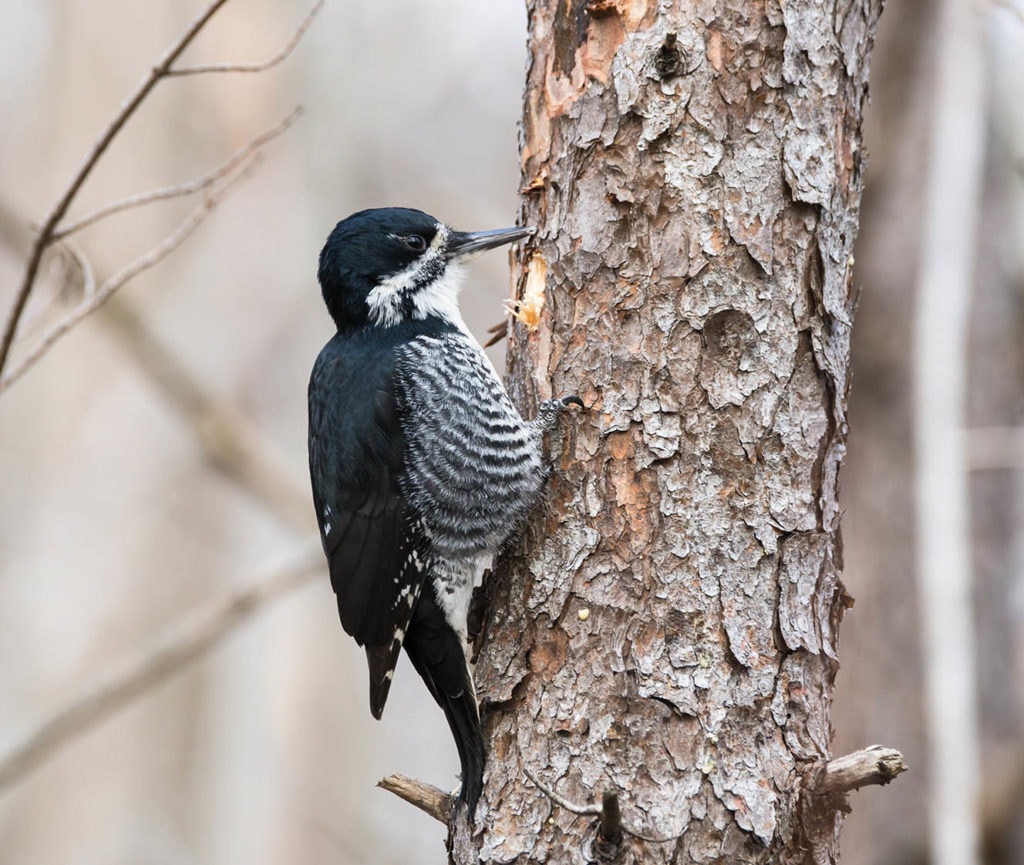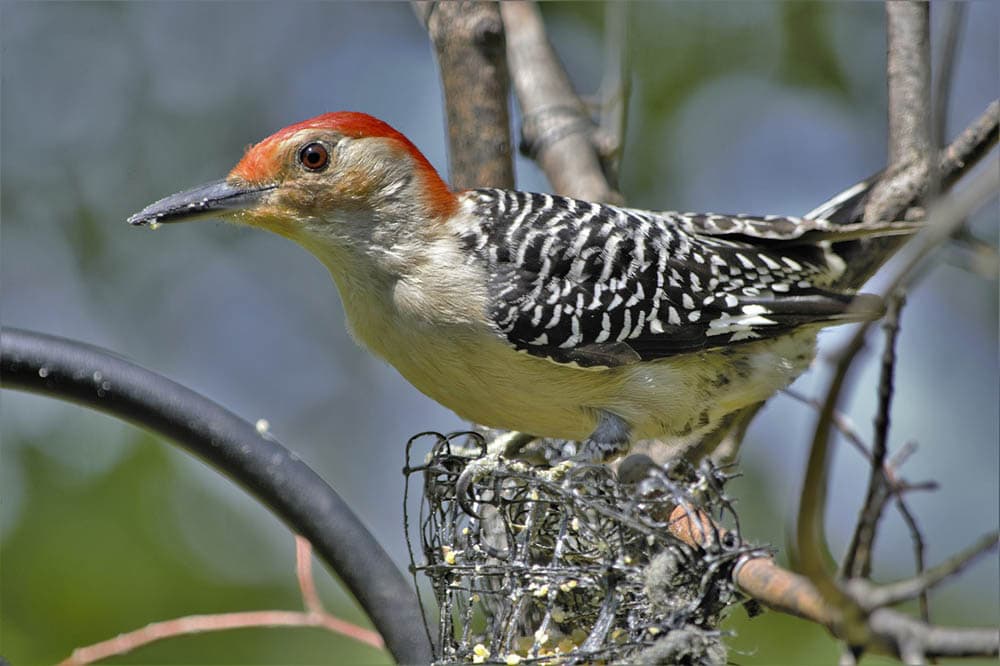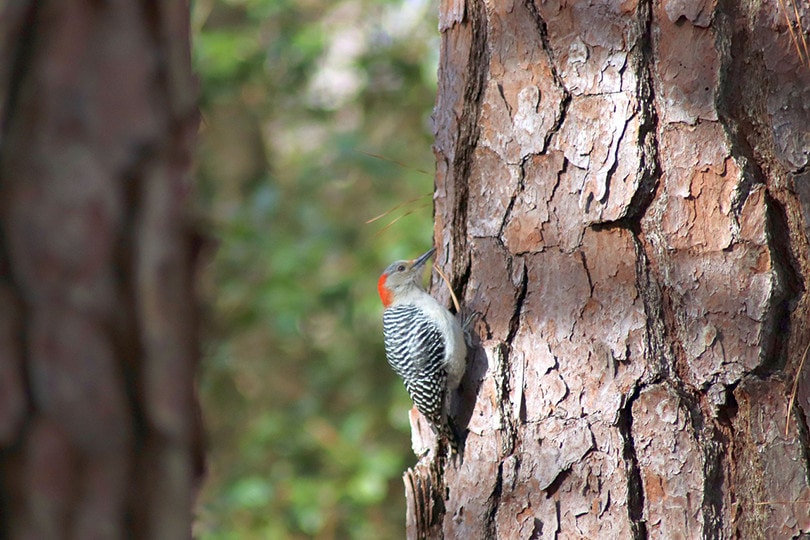7 Species of Woodpeckers in Illinois
Last Updated on

Illinois is home to seven different species of woodpeckers. These species share some similar qualities, such as having red crests. However, they also have some distinct features and vary in size.
If you are interested in birdwatching with a particular interest in spotting woodpeckers, make sure to become acquainted with their vocalizations and drumming patterns. We have some useful information that’ll help you get to know them better. With a little practice, you will be able to identify them on your own pretty quickly.
The 7 Species of Woodpeckers in Illinois
1. Downy Woodpecker

| Scientific Name: | Picoides pubecens |
| Color: | Red, black, white |
| Length: | 5-7 inches |
| Wingspan: | 9-12 inches |
The Downy Woodpecker is the smallest species of woodpecker in North America. The males have a small tuft of red on their crest and the rest of their bodies are marked with black and white feathers. Females look pretty similar to the males except they lack the red on their crest.
Along with making drumming noises, these birds can make a variety of vocalizations, including trills and rattles. You can distinguish the Downy Woodpecker’s drumming from other woodpeckers because the speed of its drumming is the slowest out of all the other species in Illinois.
2. Hairy Woodpecker

| Scientific Name: | Picoides villosus |
| Color: | Red, black, white |
| Length: | 7-10 inches |
| Wingspan: | 13-17 inches |
The Hairy Woodpecker is a medium-sized woodpecker species. Males have the smallest tuft of red on their crest, while females are black and white. These birds are excellent foragers and spend their days in deciduous forests uncovering insects.
Hairy Woodpeckers tend to be permanent residents in Illinois. They look very similar in appearance to Downy Woodpeckers. However, the trained eye can quickly tell them apart because the Hairy Woodpecker is much larger than the Downy Woodpecker.
3. Yellow-Bellied Sapsucker

| Scientific Name: | Sphyrapicus varius |
| Color: | Red, black, white |
| Length: | 7-8 inches |
| Wingspan: | 13-16 inches |
The Yellow-Bellied Sapsucker is another medium-sized woodpecker that can be found in Illinois. This species of woodpecker is similar in size to the Hairy Woodpecker, but it tends to have a lot of mottled feathers.
Yellow-Bellied Sapsuckers are very vocal and use all sorts of sounds to communicate. Males have an interesting and distinct vocalization that they use to attract mates within their territory. While these birds can drum holes into trees for feeding and nesting, they also drum against dead trees for long-distance communication.
4. Red-Bellied Woodpecker

| Scientific Name: | Melanerpes carolinus |
| Color: | Red, black, white |
| Length: | 9-11 inches |
| Wingspan: | 15-18 inches |
Red-Bellied Woodpeckers are medium-sized woodpeckers. Along with having a red crest, these birds have a pale streak of red that runs along their belly. The pale red is difficult to spot from a distance, and you’ll probably need a set of binoculars to distinguish them.
These woodpeckers tend to be a noisy bunch and have different types of calls that they use in various situations. They also like to drum to attract mates.
Red-Bellied Woodpeckers enjoy eating insects, but you can also find them eating fruits, nuts, and seeds.
5. Red-Headed Woodpecker

| Scientific Name: | Melanerpes erythrocephalus |
| Color: | Red, black, white |
| Length: | 7-10 inches |
| Wingspan: | 16-17 inches |
Red-Headed Woodpeckers are similar in shape and size to Red-Bellied Woodpeckers. However, as their name states, Red-Headed Woodpeckers have completely red heads and napes. These birds are omnivores and typically eat insects, fruits, and nuts. In some cases, they can eat small rodents and other birds’ eggs.
A unique behavior that a Red-Headed Woodpecker engages in is caching. Most other woodpeckers do not hoard food, but this particular species will store food in trees and crevices. They’ll revisit these spots whenever they need to replenish themselves.
6. Northern Flicker

| Scientific Name: | Colaptes auratus |
| Color: | Red, black, white, gray |
| Length: | 11-14 inches |
| Wingspan: | 17-21 inches |
The Northern Flicker is native to North America and passes through Illinois as they migrate from north to south. These woodpeckers prefer to feed on the ground and like to eat insects, fruits, seeds, and nuts.
You can find Northern Flickers in all kinds of habitats. They naturally like woodlands, but they can also live in parks and gardens that have a good amount of trees in them. Most Northern Flickers are migrant birds, but some that live in the southern states can be permanent residents.
7. Pileated Woodpecker

| Scientific Name: | Dryocopus pileatus |
| Color: | Red, black, white |
| Length: | 16-20 inches |
| Wingspan: | 30 inches |
Pileated Woodpeckers are the largest woodpeckers you can find in Illinois. They have an impressive crimson crest and black stripes that look like masks on their face. Both male and female Pileated Woodpeckers have the red crest, but males have an additional red streak going across their faces that looks like a mustache.
You can find and hear these woodpeckers drumming on dead trees and logs as they search for ants and other insects to eat. They also create nests in these trees, and they’re often large enough for owls, bats, and other flying animals to inhabit when they vacate them after the end of nesting season.

How To Attract Woodpeckers to Your Yard
Attracting woodpeckers to your yard can be a challenge because most species primarily eat insects and won’t show interest in traditional bird feeders. However, there are some things you can try to increase the chances of seeing woodpeckers up close in your yard.
First, you can use a bird feeder specifically designed for woodpeckers. These types of feeders are upright and provide a good grip for their feet. They should also be planted near trees so that they’re more noticeable for woodpeckers.
You can also try installing a birdbath in your yard. Just make sure that it’s situated in a more secluded space. Although woodpeckers can be noisy, they’re fairly shy and won’t fly to open and exposed spaces.
Some premade bird feeder mixes can contain treats that woodpeckers love. Look for mixes that contain peanuts, berries, and mealworms. Woodpeckers also tend to prefer protein-dense suet balls.

Conclusion
You can find a good amount of woodpecker species in Illinois. These birds are shy and like to rest on high, unreachable spots on trees. So, it can take a little time to figure out how to find them. Fortunately, they’re pretty vocal and make loud drumming noises.
So, if you hear their distinct calls and drumming, you can try setting up a feeding station catered to their preferences. With some patience and quiet observation, there’s a good chance you’ll be able to attract these birds and view them more up close.
- You might also be interested in: 7 Species of Woodpeckers in Tennessee
Featured Image Credit By FotoRequest, Shutterstock
About the Author Jessica Kim
Jessica is a freelance writer who spends most of her day researching and writing a number of topics. She loves sharing helpful information that people can use to better understand their pets, nature and the world around them. When she isn't writing, you may find her walking dogs, tending to her plant babies, or drinking her nth cup of coffee.
Related Articles:
10 Types of Hummingbirds in Arkansas (With Pictures)
8 Types of Hummingbirds in Nebraska (With Pictures)
5 Types of Hummingbirds in Idaho (With Pictures)
3 Types of Hummingbirds in Mississippi (With Pictures)
8 Types of Hummingbirds in Kansas (With Pictures)
5 Types of Hummingbirds in West Virginia (With Pictures)
5 Types of Hummingbirds in Ohio (With Pictures)
Where Do Nuthatches Nest? Nuthatch Nesting Habits Explained
